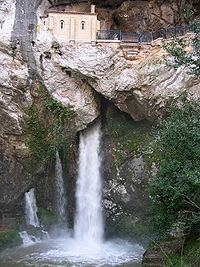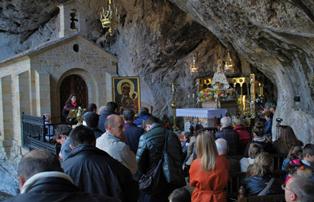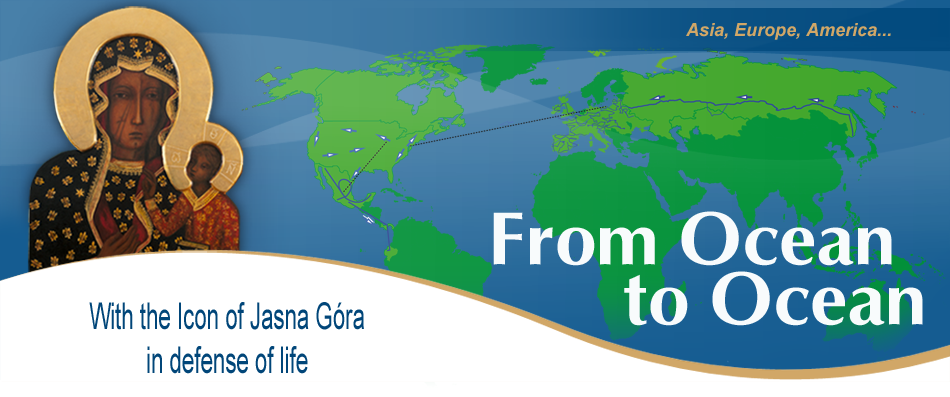On Saturday, December 22, the pilgrimage to the famous Marian shrine of Covadonga began. The Pilgrims met in the Romanesque church Cangas de Onis, where the Icon of Our Lady of Częstochowa was brought. This was a beautiful day and the sun was shining.
From the church the pilgrims carried the Icon in a procession the the Basilica Santa Maria la Real de Covadonga (The Holy Mary Queen of Covadonga). In front of the church the local custodian priest and the canonics were waiting. After the solemn Holy Eucharist, with the sound of beautiful music and singing the Icon was carried up the mountain to the grotto of the Queen of Asturian Mountains. Attired in a white robe Our Lady of Covadonga welcomed the Częstochowa Icon – the Black Madonna. In the grotto the pilgrims, many families with children among them, said the Rosary for the defence of life and family.
The celebration was attended by numerous pilgrims who came by coaches for the purpose.
Just as Jasna Góra is the spiritual heart and Christian root of Poland, Asturias is the heart and root of Christianity in Spain, for, thanks to the intercession of the Mother of God, the process of winning back the Spanish territory from the hands of the Moors started here.
In the 8th century, after Visigoth king Rodrigo (Roderick) died the country was overrun by the Muslims from Africa, a member of the Visigoth royal family called Pelayo (Pelagius) sought refuge in a grotto in these mountains. It was most probably in 716 or 718.
According to tradition, when he was praying and begging the Blessed Virgin for help he saw a glowing cross in the sky with a Latin inscription “the enemy will be defeated under this sign”. Pelayo made an oak cross and took it with him into battle. In the Asturian mountains he started an uprising against the Muslims, and this became a war for the reconquest of the country. In 722 he led his Christian army into battle at Covadonga, defeated the Moors, and forced them to withdraw from Asturias. The number of the invaders is said to have been much larger than his army.
The spot where Pelayo found refuge and prayed to the Mother of God is called Covadonga. The name comes from Latin “Cova Dominica”, i.e. The Lady`s Cave or Grotto. 20 years later king Alfonso I, called the Catholic, had a wooden monastery and a chapel of Our Lady of Cobvadonga built there. Later on, near the grotto, in place of the monastery which burnt in 1777, a basilica (Spanish Basilica de Santa María la Real de Covadonga) was built and consecrated in 1901. At the place where Pelayo stayed with his warriors, in a shallow grotto with a rocky ledge, there is now a Romanesque chapel and the statue of Our Lady of Covadonga, popularly called La Santina and venerated as the Patroness of Asturias. Pilgrims, who come all the year round to this important, spiritual and historical shrine, can reach it through a tunnel specially made for the purpose, or else climb the 101 steps. In the wall of a precipice on a high ledge there is the tomb of Don (King) Pelayo, who was elected the first king of Asturias, and also that of his son-in-law, Alfonso I the Catholic, who significantly enlarged the territories controlled by Christians. 
A golden cross, made to commemorate Don Pelayo's victory, features on the flag and the coat of arms of Asturias. This cross itself, under which he defeated his enemies, is now at Oviedo, together with other precious Christian relics, one of them being the sudarion – the Cloth or Towel of Oviedo, in which the head of Christ on the cross was wrapped.
At present in the Covadonga grotto, the statue of Our Lady of Covadonga stands on a throne, dressed in a gown and a mantle. In her hand she is holding a gold rose, the gift from Pope John Paul II which he presented during his visit here in 1989.
On Saturday afternoon, at 2,15 PM, the Częstochowa Icon, on pilgrimage From Ocean to Ocean, was ceremonially bidden farewell and the “Life Mobile” left for the seaside town of Aviles.






